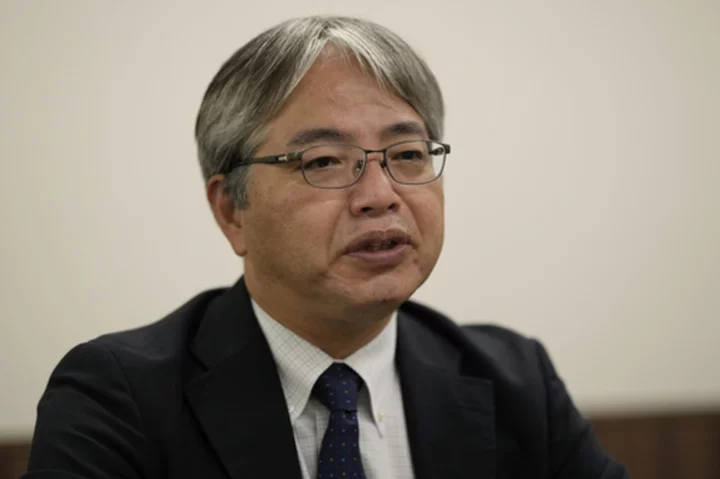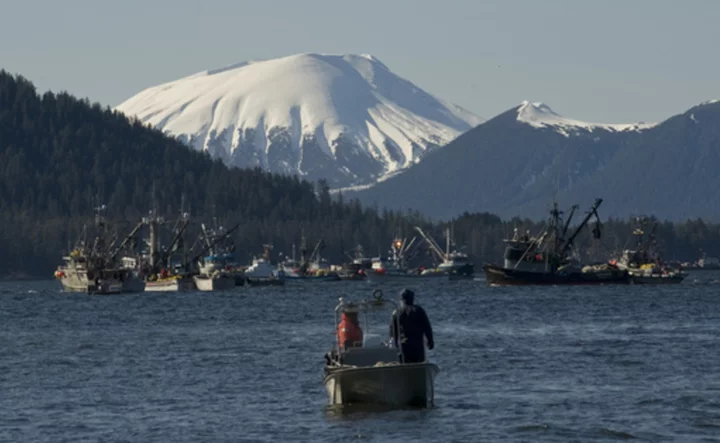TOKYO (AP) — A top official in charge of the Fukushima Daiichi nuclear power plant says an upcoming release of treated radioactive water into the sea more than 12 years after the meltdown disaster marks “a milestone,” but it's still an initial step of the daunting task of the decades-long decommissioning process that still remain.
Junichi Matsumoto, corporate officer in charge of the treated water management for Tokyo Electric Power Company Holdings, which operates the Fukushima plant, also pledged to carry out careful sampling, analysis and data disclosure of the water to make sure its release is safely carried out in accordance with International Atomic Energy Agency standards this month.
“The release of the ALPS-treated water into the sea for us is a major milestone for us, as well as for the decommissioning of the plant,” Matsumoto said in an interview with The Associated Press at TEPCO headquarters in Tokyo.
“In order to steadily put forward decommissioning, the ever-growing water was a pressing issue that we could not put off, and we had a sense of crisis,” said Matsumoto, also a nuclear engineering expert. “We must steadily accomplish this milestone, as we still have to tackle far more challenging and higher risk operations such as removal of melted debris and spent fuel.”
Another main task for TEPCO is to combat reputational damage from the water release, he said.
The March 11, 2011, earthquake and tsunami destroyed the Fukushima Daiichi plant’s cooling systems, causing three reactors to melt and contaminating their cooling water, which has since leaked continuously. The water is collected, filtered and stored in around 1,000 tanks, which will reach their capacity in early 2024.
Massive amounts of fatally radioactive melted nuclear fuel remain inside the reactors. Robotic probes have provided some information, but the status of the melted debris is largely unknown.
The government and TEPCO say the water must be removed to make room for the plant’s decommissioning, and to prevent accidental leaks from the tanks, because much of the water is still contaminated and needs retreatment.
The release plan has faced strong opposition from Japanese fishing organizations, which worry about further damage to the reputation of their seafood as they struggle to recover. Groups in South Korea and China have also raised concerns, turning it into a political and diplomatic issue.
Matsumoto said the key to gaining understanding is to patiently explain the situation by providing scientific evidence, rather than just stressing safety.
“It is difficult, but we hope to make it as easy to understand as possible,” he said. "If you describe (the water release) in one word, we can say ‘no worries.’”
"As an operator responsible for the accident, we must admit TEPCO is a company that is not fully trusted. So we must keep up the effort and sincerely respond to any concern,” Matsumoto said. “It is our responsibility to demonstrate we can carry out the water release as planned, and that’s how we can regain public trust.”
The government said the release is set to start this summer, but hasn't set the start date amid protests. TEPCO obtained safety permits for all equipment needed for the release, and is currently carrying out training for operation, emergency response and maintenance so that the water release team can get down to work any time, Matsumoto said.
“It's not like just turning a faucet to run tap water,” he said.
Scientists generally agree that the environmental impact from the treated water would be negligible, but some call for more attention on dozens of low-dose radionuclides that remain in the water, saying data on their long-term effect on the environment and marine life is insufficient and the water requires close scrutiny.
TEPCO and government officials say tritium is the only radionuclide inseparable from water and is being diluted to contain only a fraction of the national discharge cap, and that they are filtered to legally releasable levels and their environmental impact deemed minimal.
Matsumoto acknowledged that the treated water that had come in contact with the damaged fuel contains radionuclides such as uranium and plutonium that are not in the water routinely released from healthy nuclear plants around the world.
He said that the total concentration of radionuclides in the water meets government standards after treatment, and it's diluted further by massive amounts of seawater by more than 100 times, which is amply safe and deemed to have a minimal environmental impact.
Keeping the contaminated water from escaping into the environment and being safely stored at the plant was a pressing and heavy task that started immediately after the disaster, and Matsumoto has struggled to manage the water.
There were instances when plant workers had no other choice but to dump it into the sea or temporarily put it inside a basement or temporary water tanks, Matsumoto recalled.
Today, after taking measures to minimize rainwater and groundwater seeping into the reactor buildings and establishing a stable water management systems, the amount of contaminated water has come down to less than one-fifth of what it used to be.









